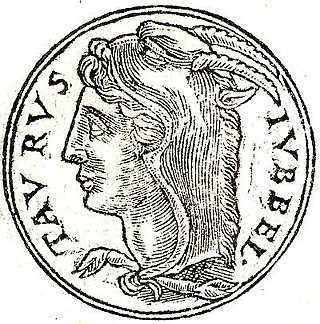Related Research Articles

The gens Petronia was a plebeian family at ancient Rome. This gens claimed an ancient lineage, as a Petronius Sabinus is mentioned in the time of Lucius Tarquinius Superbus, the last of the Roman kings, but few Petronii are mentioned in the time of the Republic. They are frequently encountered under the Empire, holding numerous consulships, and eventually obtaining the Empire itself during the brief reign of Petronius Maximus in AD 455.
The gens Acilia was a plebeian family at ancient Rome, that flourished from the middle of the third century BC until at least the fifth century AD, a period of seven hundred years. The first of the gens to achieve prominence was Gaius Acilius, who was quaestor in 203 and tribune of the plebs in 197 BC.
The praenomen was a personal name chosen by the parents of a Roman child. It was first bestowed on the dies lustricus, the eighth day after the birth of a girl, or the ninth day after the birth of a boy. The praenomen would then be formally conferred a second time when girls married, or when boys assumed the toga virilis upon reaching manhood. Although it was the oldest of the tria nomina commonly used in Roman naming conventions, by the late republic, most praenomina were so common that most people were called by their praenomina only by family or close friends. For this reason, although they continued to be used, praenomina gradually disappeared from public records during imperial times. Although both men and women received praenomina, women's praenomina were frequently ignored, and they were gradually abandoned by many Roman families, though they continued to be used in some families and in the countryside.
The gens Gavia, or occasionally Gabia, was a Roman family of plebeian descent. It first appears in history during the first century BC, but none of its members obtained any of the curule magistracies until imperial times. The Gavi Arch at Verona was built in honor of one of the Gavii.

The gens Julia was one of the most prominent patrician families in ancient Rome. Members of the gens attained the highest dignities of the state in the earliest times of the Republic. The first of the family to obtain the consulship was Gaius Julius Iulus in 489 BC. The gens is perhaps best known, however, for Gaius Julius Caesar, the dictator and grand uncle of the emperor Augustus, through whom the name was passed to the so-called Julio-Claudian dynasty of the first century AD. The nomen Julius became very common in imperial times, as the descendants of persons enrolled as citizens under the early emperors began to make their mark in history.

The gens Lutatia, occasionally written Luctatia, was a plebeian family of ancient Rome. The first of the gens to obtain the consulship was Gaius Lutatius Catulus in 242 BC, the final year of the First Punic War. Orosius mentions their burial place, the sepulchrum Lutatiorum, which lay beyond the Tiber.

The gens Vibia was a plebeian family at ancient Rome. Although individuals named Vibius appear in history during the time of the Second Punic War, no members of this gens are found at Rome until the final century of the Republic. The first of the Vibii to obtain the consulship was Gaius Vibius Pansa in 43 BC, and from then until imperial times the Vibii regularly filled the highest offices of the Roman state. The emperors Trebonianus Gallus and Volusianus each claimed descent from the family.

The gens Antonia was a Roman family of great antiquity, with both patrician and plebeian branches. The first of the gens to achieve prominence was Titus Antonius Merenda, one of the second group of Decemviri called, in 450 BC, to help draft what became the Law of the Twelve Tables. The most prominent member of the gens was Marcus Antonius.

The gens Canuleia was a minor plebeian family at ancient Rome. Although members of this gens are known throughout the period of the Republic, and were of senatorial rank, none of them ever obtained the consulship. However, the Canuleii furnished the Republic with several tribunes of the plebs.
The gens Septimia was a minor plebeian family at ancient Rome. The gens first appears in history towards the close of the Republic, and they did not achieve much importance until the latter half of the second century, when Lucius Septimius Severus obtained the imperial dignity.
The gens Cestia was a plebeian family at ancient Rome during the later Republic, and in imperial times. The first member of the gens to obtain the consulship was Gaius Cestius Gallus in AD 35. The family's name is commemorated on two monuments, the Pons Cestius and the Pyramid of Cestius which survive into modern times.
The gens Fannia was a plebeian family at ancient Rome, which first appears in history during the second century BC. The first member of this gens to attain the consulship was Gaius Fannius Strabo, in 161 BC.
The gens Hateria, occasionally Ateria, was a plebeian family at ancient Rome, known from the last century of the Republic and under the early Empire. The most distinguished of the Haterii was Quintus Haterius, a senator and rhetorician in the time of Augustus and Tiberius. He was consul suffectus in 5 BC.

The gens Neria was a minor plebeian family at Rome. Members of this gens are first mentioned in the time of Caesar, when Gnaeus Nerius was quaestor, but few if any others are known to have held Roman magistracies. Many Nerii are known from inscriptions. A coin issued by the quaestor Nerius depicts the head of Saturn on the obverse, and standards labeled with the names of the consuls on the reverse, perhaps alluding to Caesar having broken open the treasury, or showing the legitimacy of the Senate to the legions against the rebellion of Caesar.
The gens Numitoria was an ancient but minor plebeian family at ancient Rome. The first member of this gens to appear in history was Lucius Numitorius, elected tribune of the plebs in 472 BC. Although Numitorii are found down to the final century of the Republic, none of them ever held any of the higher magistracies.
The gens Ovidia was a plebeian family of ancient Rome. Only a few members of this gens are mentioned in history, of whom the most famous is unquestionably the poet Publius Ovidius Naso, but others are known from inscriptions.
The gens Pactumeia was a minor plebeian family at ancient Rome. Members of this gens are not mentioned by the historians until imperial times, when one branch of the family achieved high rank, holding several consulships during the first and second centuries.
The gens Papinia was a plebeian family at ancient Rome. Members of this gens are first mentioned toward the end of the Republic. In imperial times, the family achieved some prominence, with Sextus Papinius Alienus holding the consulship in AD 36. The nomen Papinius is sometimes confused with the more common Papirius and Pomponius.
The gens Satria was a minor plebeian family at ancient Rome. Members of this gens are mentioned in the first century BC, and under the early Empire, but none of them rose higher than the rank of praetor. Otherwise the Satrii are known largely from inscriptions.

The gens Statilia was a plebeian family of Lucanian origin at ancient Rome. Members of this gens are first mentioned in the third century BC, when one of them led the Lucanian assault on the city of Thurii, and another commanded an allied cavalry troop during the Second Punic War; but at Rome the Statilii first come to attention in the time of Cicero, at which point they held equestrian rank. The first of the family to attain the consulship was Titus Statilius Taurus in 37 BC, and his descendants continued to fill the highest offices of the Roman state until the time of Marcus Aurelius.
References
- ↑ Dictionary of Greek and Roman Biography and Mythology , William Smith, Editor.
- ↑ Chase, p. 120.
- 1 2 Chase, pp. 136–138.
- ↑ Chase, pp. 113, 114.
- ↑ Chase, pp. 109, 110.
- ↑ SIG, 747.
- ↑ Cicero, In Verrem, iii. 40.
- ↑ Broughton, vol. II, p. 115.
- ↑ Tacitus, Annales, xv. 64.
- ↑ Bastianini, "Lista dei prefetti d'Egitto", pp. 295 ff.